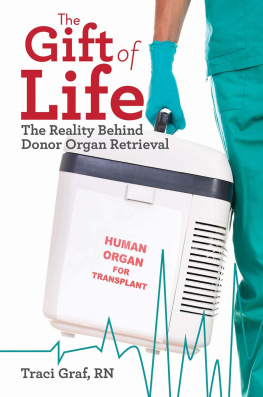Traci Graf - The Gift of Life: The Reality Behind Donor Organ Retrieval
Here you can read online Traci Graf - The Gift of Life: The Reality Behind Donor Organ Retrieval full text of the book (entire story) in english for free. Download pdf and epub, get meaning, cover and reviews about this ebook. year: 2014, publisher: Firefly Books, genre: Science fiction. Description of the work, (preface) as well as reviews are available. Best literature library LitArk.com created for fans of good reading and offers a wide selection of genres:
Romance novel
Science fiction
Adventure
Detective
Science
History
Home and family
Prose
Art
Politics
Computer
Non-fiction
Religion
Business
Children
Humor
Choose a favorite category and find really read worthwhile books. Enjoy immersion in the world of imagination, feel the emotions of the characters or learn something new for yourself, make an fascinating discovery.
- Book:The Gift of Life: The Reality Behind Donor Organ Retrieval
- Author:
- Publisher:Firefly Books
- Genre:
- Year:2014
- Rating:4 / 5
- Favourites:Add to favourites
- Your mark:
- 80
- 1
- 2
- 3
- 4
- 5
The Gift of Life: The Reality Behind Donor Organ Retrieval: summary, description and annotation
We offer to read an annotation, description, summary or preface (depends on what the author of the book "The Gift of Life: The Reality Behind Donor Organ Retrieval" wrote himself). If you haven't found the necessary information about the book — write in the comments, we will try to find it.
Traci Graf: author's other books
Who wrote The Gift of Life: The Reality Behind Donor Organ Retrieval? Find out the surname, the name of the author of the book and a list of all author's works by series.
The Gift of Life: The Reality Behind Donor Organ Retrieval — read online for free the complete book (whole text) full work
Below is the text of the book, divided by pages. System saving the place of the last page read, allows you to conveniently read the book "The Gift of Life: The Reality Behind Donor Organ Retrieval" online for free, without having to search again every time where you left off. Put a bookmark, and you can go to the page where you finished reading at any time.
Font size:
Interval:
Bookmark:
Print edition published by Firefly Books Ltd. 2014
Copyright 2014 Firefly Books Ltd.
Text Copyright 2014 Traci Graf
eBook copyright 2014
ePUB ISBN: 978-1-77085-415-4
All rights reserved. No part of this publication may be reproduced, stored in a retrieval system, or transmitted in any form or by any means, electronic, mechanical, photocopying, recording or otherwise, without the prior written permission of the Publisher or a license from The Canadian Copyright Licensing Agency (Access Copyright). For an Access Copyright license, visit www.accesscopyright.ca or call toll free to 1-800-893-5777.
Published in Canada by
Firefly Books Ltd.
50 Staples Avenue, Unit 1
Richmond Hill, Ontario L4B 0A7,
Cover design: Hartley Millson
Author photo: Jennifer Jacono
Cover photo: uchar/E+/Getty Images
Illustrations: Shutterstock Hein Nouwens
The publisher gratefully acknowledges the financial support for our publishing program by the Government of Canada through the Canada Book Fund as administered by the Department of Canadian Heritage.

I ts important to understand the brain death process in order to completely understand the miracle of organ donation. Brain death is like being pregnant, you either are or you arent, there is nothing in between. We know that certain injuries are more likely to lead to brain death than others. The brain is soft and easily pushed aside by blood or fluid in the skull. The patient could have a spontaneous bleed, a hemorrhagic stroke, a collection of fluid from an area deprived of oxygen or, of course, trauma. The skull is an enclosed space and the brain, fluid and spaces need to be in perfect balance for us to function, even a small collection of fluid or hydrocephalus can cause obvious, sometimes frightening, symptoms. We were trained to know how brain death happens so we knew how to explain it when we talked to the family. The moment when a patient actually becomes brain dead is when the brain is pushed so far down into the skull it literally slides through the foramen magnum, which is the hole in the bottom of our skulls where the brain and brain stem connect. This is called herniation and it is the most common time for a patient to become unstable; realize though we are talking about a transition to brain death, not saving the patients life.
I was on a case far away from home and far away from any other Transplant Coordinators coming to my rescue. The donors daughter had waited almost three days for her mother to progress to brain death when I was paged due to the patients blood pressure dropping, the first sign the patient may be herniated. I rushed back into the room and found the daughter literally praying that a merciful, non-prolonged end would come for her mother. Her blood pressure was starting to dip dangerously low 100/60 to 90/50so I asked the Intensive Care Unit (ICU) nurse to please hang the medication that would support the blood pressure next to the bed. She kept saying, its right in the Pyxis, which is the computerized pharmacy system many hospitals have, but I kept insisting she hang it on the pole next to the bed. She finally agreed and it wasnt a minute later that the mothers blood pressure totally dropped. The last thing you want to happen is have the patient code or go into cardiac arrest and, if it was going to happen, it would be at this point. What we call a code in the medical field can be loss of a heartbeat, a loss of heart rhythm or loss of blood pressure. It is extremely important that an organ donors organs receive all the blood and oxygen they can while in a dying body. Given this, when you know a patient is irreversibly brain injured and they are progressing to brain death, you do not want them to have a cardiac arrest. Thankfully the nurse had finally listened to me just before it happened so we were able to get the mother through it and she lost all reflexes, resulting in brain death. The pressure of having a family who wants this to happen and is actually in the room as you give directions on how much and what drugs to give is unbelievable.
People have a misconception that brain death is like being in a coma. It is not at all like a comaunless you have been given a paralytic agent, anyone, even in a coma, will still have their protective reflexes. These are the last reflexes that remain functioning and the reflexes that are individually tested before brain death is pronounced. If someone pokes you in the eye with something you should blink, if someone puts something down your throat you should gag or cough, if they shine a light in your eyes your pupils should constrict or shrink, if they roll a pen firmly over your cuticles you should draw back your hand in response to the pain. None of these reflexes are present if someone is brain dead. Declaring someone brain dead is a very specific process that is consistent but also allows some hospitals minor differences. They can do two brain death exams and an apnea test if the donor is stable. An apnea test consists of disconnecting the ventilator at the endotracheal tube for a period of about five minutes. We say that a patient passed the apnea test if they did not take a breath and failed if they breathed. Or they can do whats called a confirmatory study, which would be a cerebral blood flow study followed by one exam and always an apnea test.
To pronounce someone brain dead requires two different physicians to certify the information is consistent. They confirm that the patient is within the normal ranges for things that could potentially mask reflexes. The patient must respond in the same way for each reflex tested when both physicians go through the exam, usually 24 hours apart. The form in almost every hospital has two columns and they must certify that the following items are stable or within normal limits: no electrolyte imbalances can be present since elevated sodium can mask reflexes, no paralytics or sedatives can be present and if the patient was given something like phenobarb they need to draw blood to be sure it is all gone from the system. It is common for brain-injured patients to be placed in a pentobarb or phenobarb coma. Patients are frequently placed by their doctors into a drug-induced coma to rest the brain and bodyit slows the inflammatory process and keeps the brain from swelling so much after an injury.
The patients acid/base blood levels must be stable for the apnea test to be correct. There were many times that we spent hours trying to correct an arterial blood gas level to do the apnea test either by increasing sodium bicarb or adjusting the respiratory rate on the ventilator. The rate on the ventilator corresponds to the number of times the vent will breathe for you per minute. How much CO the patient is blowing off or retaining can dramatically affect a blood gas level. Respiratory therapists are an integral part of this process and if they are not on board it can make life difficult for the TC onsite. The patient has to be normothermic, meaning having a normal body temperature of 98.6F, because a low body temperature can mask reflexes. Each criteria on the form has a range of normal values that the patient needs to be within to be legally brain dead and by signing it, the doctor is certifying they are within that range. Lab tests are completed to certify someone is within normal range, for example, the normal sodium level is between 135 and 145 mEq/L in our blood. The brain death exam paperwork, usually the first page of at least two, asks if the patient has electrolytes within normal limitsthe main ones being sodium and potassium because they make our heart muscles contract. Once that has been established they can begin the first exam to test the reflexes mentioned earlier: cough/gag, corneal reflex, pupillary reflex, withdraw from pain and the cold calorics, which is ice water in the ear. I once had a neurologist tell me cold calorics could wake the dead. The doctors also check for something called dolls eyes, and then finally the respiratory drive or effort. Dolls eyes were named after those old-fashioned baby dolls whose eyes rolled around. If a patient is brain dead the eyes will roll around when the head is moved side to side. Fewer medical students and residents today are familiar with what those dolls were like so you date yourself if you can remember them.
Next pageFont size:
Interval:
Bookmark:
Similar books «The Gift of Life: The Reality Behind Donor Organ Retrieval»
Look at similar books to The Gift of Life: The Reality Behind Donor Organ Retrieval. We have selected literature similar in name and meaning in the hope of providing readers with more options to find new, interesting, not yet read works.
Discussion, reviews of the book The Gift of Life: The Reality Behind Donor Organ Retrieval and just readers' own opinions. Leave your comments, write what you think about the work, its meaning or the main characters. Specify what exactly you liked and what you didn't like, and why you think so.











